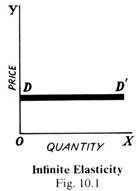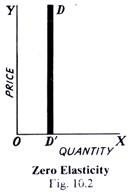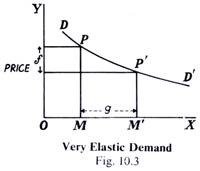Elasticity means sensitiveness or responsiveness of demand to the change in price. Read this article to learn about the Meaning and Types of Elasticity of Demand which is explained with diagrams.
Meaning of Elasticity of Demand:
Demand extends or contracts respectively with a fall or rise in price. This quality of demand by virtue of which it changes (increases or decreases) when price changes (decreases or increases) is called Elasticity of Demand.
“The elasticity (or responsiveness) of demand in a market is great or small according as the amount demanded increases much or little for a given fall in price, and diminishes much or little for a given rise in price”. – Dr. Marshall.
Elasticity means sensitiveness or responsiveness of demand to the change in price.
ADVERTISEMENTS:
This change, sensitiveness or responsiveness, may be small or great. Take the case of salt. Even a big fall in its price may not induce an appreciable ex appreciable extension in its demand. On the other hand, a slight fall in the price of oranges may cause a considerable extension in their demand. That is why we say that the demand in the former case is ‘inelastic’ and in the latter case it is ‘elastic’.
The demand is elastic when with a small change in price there is a great change in demand; it is inelastic or less elastic when even a big change in price induces only a slight change in demand. In the words of Dr. Marshall, “The elasticity (or responsiveness) of demand in a market is great or small according as the amount demanded increases much or little for a given fall in price, and diminishes much or little for a given rise in price.”But the demand cannot be perfectly ‘elastic’ or ‘inelastic’.
Completely elastic demand will mean that a slight fall (or rise) in the price of the commodity concerned induces an infinite extension (or contraction) in its demand. Completely inelastic demand will mean that any amount of fall (or rise) in the price of the commodity would not induce any extension (or contraction) in its demand. Both these conditions are unrealistic. That is why we say that elasticity of demand may be ‘more or less’, but it is seldom perfectly elastic or absolutely inelastic.
Types of Elasticity:
Distinction may be made between Price Elasticity, Income Elasticity and Cross Elasticity. Price Elasticity is the responsiveness of demand to change in price; income elasticity means a change in demand in response to a change in the consumer’s income; and cross elasticity means a change in the demand for a commodity owing to change in the price of another commodity.
Degrees of Elasticity of Demand:
ADVERTISEMENTS:
We have seen above that some commodities have very elastic demand, while others have less elastic demand. Let us now try to understand the different degrees of elasticity of demand with the help of curves.
(a) Infinite or Perfect Elasticity of Demand:
Let as first take one extreme case of elasticity of demand, viz., when it is infinite or perfect. Elasticity of demand is infinity when even a negligible fall in the price of the commodity leads to an infinite extension in the demand for it. In Fig. 10.1 the horizontal straight line DD’ shows infinite elasticity of demand. Even when the price remains the same, the demand goes on changing.
(b) Perfectly Inelastic Demand:
ADVERTISEMENTS:
The other extreme limit is when demand is perfectly inelastic. It means that howsoever great the rise or fall in the price of the commodity in question, its demand remains absolutely unchanged. In Fig. 10.2, the vertical line DD’ shows a perfectly inelastic demand. In other words, in this case elasticity of demand is zero. No amount of change in price induces a change in demand.
In the real world, there is no commodity the demand for which may be absolutely inelastic, i.e., changes in its price will fail to bring about any change at all in the demand for it. Some extension/contraction is bound to occur that is why economists say that elasticity of demand is a matter of degree only. In the same manner, there are few commodities in whose case the demand is perfectly elastic. Thus, in real life, the elasticity of demand of most goods and services lies between the two limits given above, viz., infinity and zero. Some have highly elastic demand while others have less elastic demand.
(c) Very Elastic Demand:
Demand is said to be very elastic when even a small change in the price of a commodity leads to a considerable extension/contraction of the amount demanded of it. In Fig. 10.3, DD’ curve illustrates such a demand. As a result of change of T in the price, the quantity demanded extends/contracts by MM’, which clearly is comparatively a large change in demand.
(d) Less Elastic Demand:
When even a substantial change in price brings only a small extension/contraction in demand, it is said to be less elastic. In Fig. 10.4, DD’ shows less elastic demand. A fall of NN’ in price extends demand by MM’ only, which is very small.



